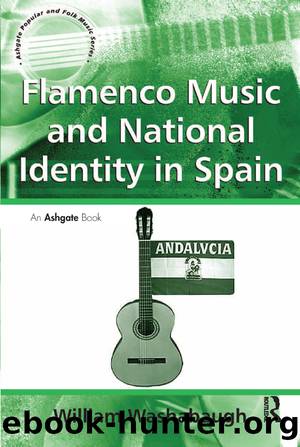Flamenco Music and National Identity in Spain by William Washabaugh

Author:William Washabaugh [Washabaugh, William]
Language: eng
Format: epub
Tags: Social Science, Anthropology, Cultural & Social
ISBN: 9781317134862
Google: gH0GDAAAQBAJ
Publisher: Routledge
Published: 2016-04-15T03:21:45+00:00
Figure 7.1 Centerfold of the booklet that accompanies the CD âFlamenco por AndalucÃa, España y la humanidadâ
After listening to these tracks, one might reasonably conclude that this 2005 recording is an unsurprising example of regional patriotism. It consists of predictably intense expressions of regional pride by people whose interests were suppressed for 40 years. However, two features of this recording distinguish it from most other anthem-projects while simultaneously anchoring it solidly in the historical tradition of flamenco. The first is the heavy role played by lyrics. The second is the solo rendition of the anthem.
First, this anthem is more solidly anchored in its lyrics than most anthems. It is certainly more deeply invested in lyrics than the Spanish national anthem, La Marcha Real, which, for most of its life, has been an instrumental anthem with no lyrics at all. And it is more profoundly dependent on its lyrics than most anthems with distinctive melodies, the instant recognizability of which is significant in itself, for example the Marseillaise and the Star Spangled Banner. Unlike these other anthems, the Andalusian anthem, especially in this recording, places special emphasis on the lyrics.42
The flamenco singers who recorded the tracks for this project rendered the lyrics in the distinctively reverential manner characteristic of the flamenco style. Typically flamenco singers internalize lyrics, creatively reworking them, making them their own so that they become newly inspirational. Accordingly, some cantaores on the CD revised the order of the words in the anthem. Others adjusted timing and emphasis, or they reshaped the words through melismas, sometimes to the point of rendering the words almost incomprehensible, all so as to draw out the otherwise hidden force of the poetry. These singers operated with a distinctively Andalusian inclination to see something in poetry other than the logic of reason. For them, the lyrics are just the launch pads for the poetic process. It is the singers who produce the real lift-off by creatively manipulating the words, always with explosive force. It is not difficult to ferret out the source of this Andalusian aesthetic. It sprang out of late-nineteenth-century krausism, with its heavy emphasis on poetic arts. And it thrived in the wake of Demófiloâs emphasis on âpoetas del puebloâ as the heart and soul of the flamenco style.
The second distinguishing feature of this flamenco anthem is its solo singing. Almost all the tracks present the anthem in one individualâs voice. It could hardly be otherwise since cante flamenco has been described, definitively and seemingly conclusively, as monody, song in solo; and it has been described so not only by flamencologists in Spain, but by ethnomusicologists looking at Spanish music from the outside.43 Cante, a melismatic song style, is difficult to even imagine in a choral format.
The solo anthem is especially interesting because elsewhere anthems are normally apt for choral expressions. Indeed, a choral rendition is desirable, if not essential, for almost all other European anthems, because such singing creates what Philip Bohlman described as a âunisonalâ enactment of the nation.44 But the flamenco anthem is non-unisonal.
Download
This site does not store any files on its server. We only index and link to content provided by other sites. Please contact the content providers to delete copyright contents if any and email us, we'll remove relevant links or contents immediately.
The Social Psychology of Inequality by Unknown(2984)
Make Comics Like the Pros by Greg Pak(2879)
Stacked Decks by The Rotenberg Collection(2836)
Purple Hibiscus by Chimamanda Ngozi Adichie(2724)
The Queen of Nothing by Holly Black(2532)
The Art of Doom by Bethesda(2126)
Life of Elizabeth I by Alison Weir(2047)
Putin's Labyrinth(1980)
The Power of Habit: Why We Do What We Do in Life and Business by Charles Duhigg(1964)
Drawing Down the Moon by Margot Adler(1840)
Things Are What You Make of Them: Life Advice for Creatives by Adam J. Kurtz(1834)
Agency by William Gibson(1797)
Wall and Piece by Banksy(1791)
Art Of Atari by Tim Lapetino(1769)
Teaching to Transgress: Education as the Practice of Freedom (Harvest in Translation) by Bell Hooks(1731)
The Beatles Lyrics by Hunter Davies(1694)
The Pin-Up Art of Bill Ward by Bill Ward(1670)
Only What's Necessary: Charles M. Schulz and the Art of Peanuts by Chip Kidd(1666)
The Andy Warhol Diaries by Andy Warhol(1573)
